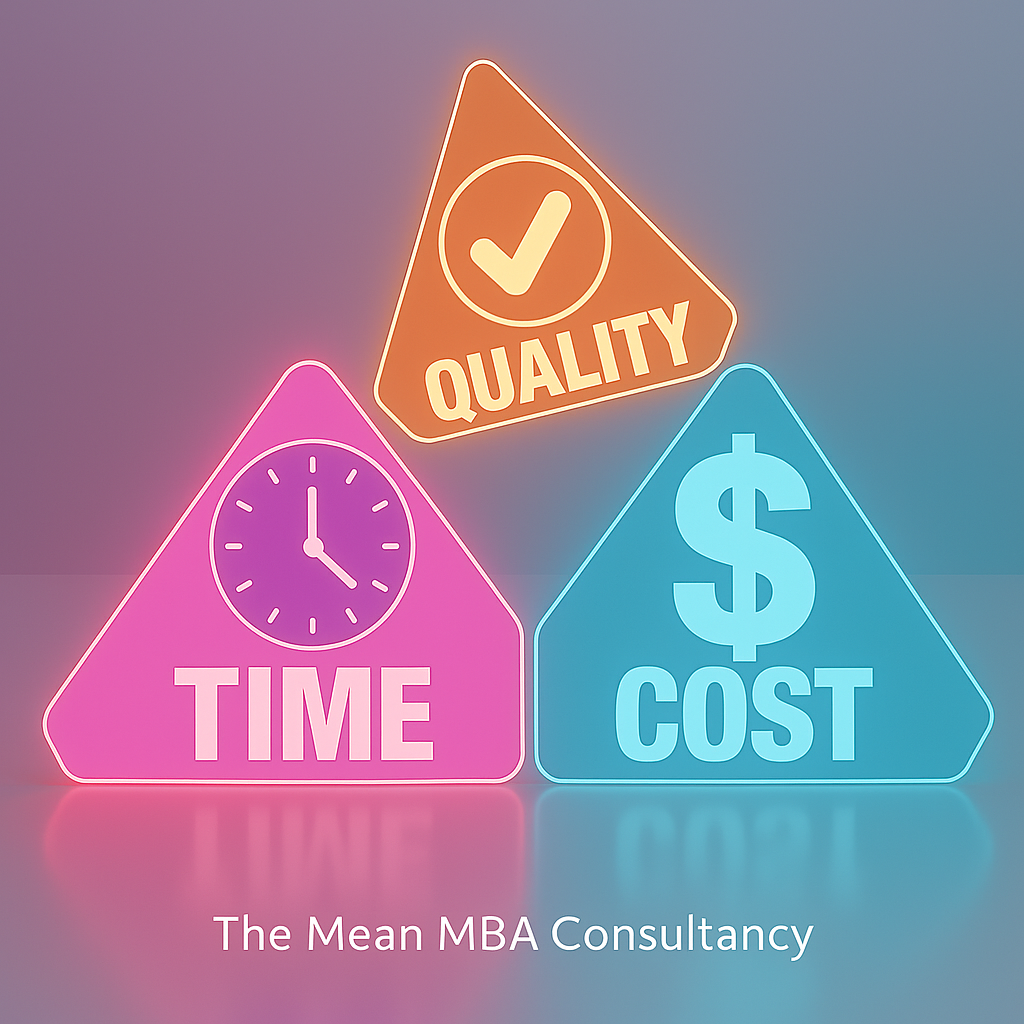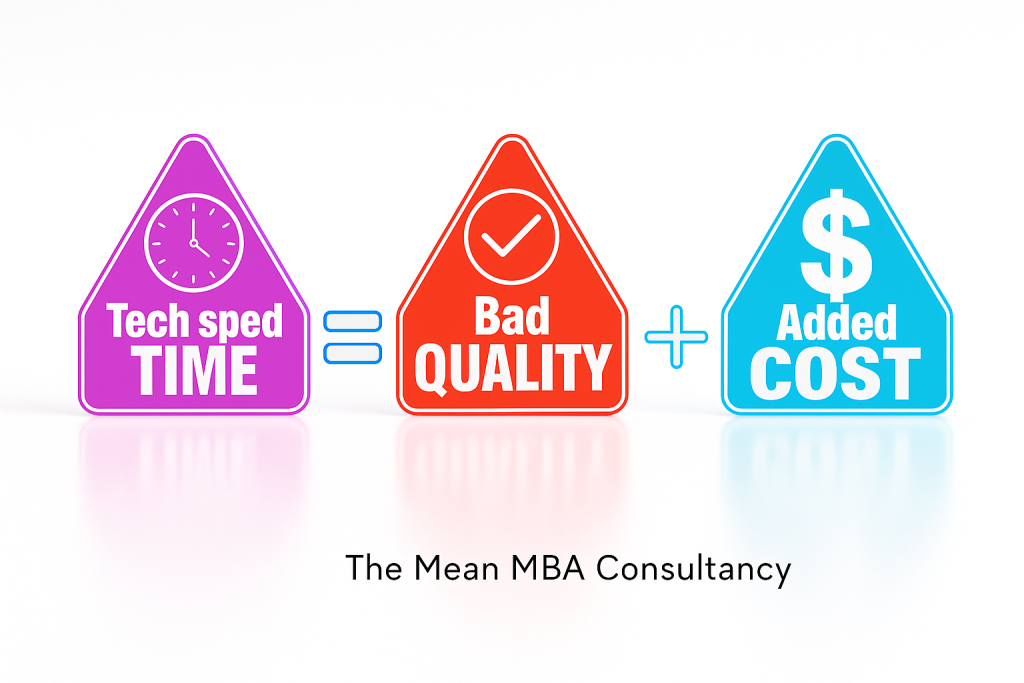This analysis examines how the current talent shortage crisis stems from technology acceleration and operational imbalance in modern businesses. When organizations rapidly implement new technologies without balancing natural dynamics of business operational with worker wellbeing, the result is mental overload, burnout, and workforce attrition—key contributing factors to today’s persistent talent shortage.
Introduction
The US talent shortage isn’t about a lack of talented people—it’s the inevitable consequence of imbalanced business operations.
We expected technology to revolutionize business operations, accelerating product and service creation without accounting for the human cost of compressed timelines. We failed to recognize that people would have less time to analyze and apply their judgment to make quality decisions.
The talent shortage results from neglecting the natural dynamics of business operations, leaving organizations vulnerable to:
- Revenue decline
- Poor quality of work, dissatisfied customers
- High replacement costs when employees burn out
These aren’t anomalies—they’re natural reactions to imbalanced systems.
During strategic planning, CEOs should consider real-world constraints that could potentially hinder execution. If not, the strategic plan would be realized.
CEOs must consider three critical real-world constraints: Quality, Time, and Cost. These elements represent the the natural dynamics of business operations a business faces when a strategic plan is operationalized.
If a CEO overlooks these dynamics, the COO, as owner of operations, should learn on operational strategy and adjust the plan.

To balance these dynamics, we must manage the interplay between quality, time, and cost.
When we adjust one element, the other two react, requiring intentional adjustments to maintain balance. This ensures the business operates optimally on a daily basis.
The goal is to balance these three dynamics to achieve optimal outcomes.
We use the following framework to help us do so:
- Low Cost + Short Time = Lower Quality
- High Quality + Short Time = Higher Cost
- High Quality + Low Cost = Longer Time

Tech Accelerated Operations – Balance = Quality Issues + Financial Burden
How does the labor shortage fit in?
Cause = Tech Accelerated Operations – Balance
We’ve continuously introduced new technological advances to increase throughput and production. Each introduction successfully produced faster results at lower costs as intended.
However, by failing to balance business operations, we neglected to ask: how is the person operating this accelerated technology affected by the increase in production?
Effect = Quality Issues + Financial Burden
Imbalanced business operations create mentally overloaded, encumbered people, along with the costs of replacing staff, training new hires, and reworking mistakes. By ignoring the human element behind accelerated operations, operational realities accumulated until the Talent shortage emerged.

Human Limits Ignored = Friction
Human Limits Ignored = Friction
We disregarded the mental limits of human cognition, resulting in people unable to adapt to acceleration—creating massive friction.
Since we cannot speed up the human brain or eliminate basic human needs, so we’ve thrown up our hands and left people to fend for themselves.
The result? Overwhelming burnout.
People now face impossible expectations: produce more, work faster, achieve perfection—all because we placed excessive faith in technological advances. We fell for the marketing siren song, blinded by shiny features and the allure of increased revenue with no downside.
Now the entire American business landscape is experiencing the consequences—the operational reality we call the talent shortage.
Rather than balancing business operations, we’ve doubled down on failed approaches—trying to hire our way out, purchase solutions, and when these surface-level fixes fail, we blame each other.
Inside Unbalanced Environment
What does the environment that caused the talent shortage look like in daily business operations?
It looks like workers navigating five platforms, six dashboards, three bosses, and a to-do list that was never humanly possible. It looks like leaders firefighting all day, unable to plan or breathe.
It looks like exhaustion disguised as performance.
The frontline employee? They work in unsustainable conditions—not because anyone’s cruel, but because the natural dynamics of business operations weren’t considered. They extinguish fires, absorb confusion, and blame themselves for not being more efficient.
The manager? They’re supposed to support their team, but the tools don’t connect, priorities shift constantly, and expectations remain disconnected from reality.
The executive? They’ve worked every moment of every day, pushing for growth—but the company never quite achieves alignment. The people care. The product works. The plan sounds good. But something keeps slipping through the cracks.
It doesn’t just slow performance or reduce revenue. It hurts people.
It erodes morale, clarity, health, and confidence. It transforms thoughtful professionals into reactive machines.
And eventually, even the most passionate people stop trying and become victims of the talent shortage.
Output Is Friction
People haven’t suddenly become lazy, teams haven’t lost motivation, and leaders haven’t forgotten how to lead. Rather, technology has fundamentally transformed how we work—and we failed to account for the strategic trade-offs.
We set ambitious goals and implemented new tools without asking crucial operational questions that allow us to balance business operations: What changes are required? What are the risks? Do we have the capacity? What support systems will absorb the natural strain of acceleration?
When the inevitable occurs—quality suffers, clarity vanishes, teams fall behind—we blame each other. We misdiagnose it as a talent shortage, labeling it resistance, underperformance, or incompetence.
The talent shortage isn’t surprising—it’s a predictable outcome. We ignored the fundamentals of business operations, reacting as unintentional errors and friction became built directly into our businesses.
We lose energy, then money, then ourselves, and finally, the purpose of the business is swept away. The focus shifts from business intent to mere survival.
The talent shortage isn’t about people at all—it’s the direct result of our collective failure to balance business operations.
Collective Failure to Balance Business Operations
This isn’t Millennials’ or Gen-Z’s fault. No—for decades we collectively watched operational realities leak into everyday business, but until recently they were easy to overlook.
Before the internet and other technological advances, business moved at a slower pace with simpler expectations. You could lead by intuition and still keep things functioning with improvisation and good intentions.
That era has ended.
For decades, we believed we could out-hustle operational realities we didn’t account for. We treated fundamentals of business operations as optional, assuming there was no need to understand systems, structure, or operational design—just grit, pride, and forceful personality.
We’ve mislabeled this as a talent shortage, claiming “Nobody wants to work.” We’ve blamed declining loyalty, poor communication, and resistance to change.
Now we’re watching everything buckle under the weight of our neglect.
We didn’t just miss the mark—we failed to build business environments where people could actually function effectively.
We treated people as disposable assets.
The talent challenges we face today aren’t anomalies. They’re predictable outcomes flowing directly from a business landscape that systematically ignored the fundamentals of business operations.
Talent Shortage + AI = No Return
What most people call a “talent shortage” is actually our own creation. It’s what happens when we don’t consider the natural dynamics of business operations.
We’ve expected people to deliver results regardless of the operational realities that demanded acknowledgment.
And instead of questioning why these operational realities manifest, we created a new narrative: “No one wants to work anymore.”
Now here comes AI—and if we’re not careful, we’re about to repeat the same mistake.
But worse.
AI accelerates production. It increases output. It compresses planning cycles. This means even more errors and friction. Less time for human cognition.
The problems we’re experiencing—burnout, breakdown, bottlenecks—won’t resolve themselves.
If we don’t consider the natural dynamics of business operations, there will be too much friction to move forward. There won’t be any workforce left to exhaust.
It’s time to start preparing. AI introduces more speed, which increases errors and costs if left unbalanced. If we don’t account for these dynamics, we’ll only sink deeper into dysfunction.
And the further we venture into an AI-driven business landscape, the more likely that becomes.
We’ll automate chaos. We’ll scale inefficiency. We’ll burn through talented people faster and blame it on their attitude—instead of recognizing it as a predictable reaction

How to Fix The Talent Shortage
Business is moving fast—and AI accelerates everything. There will be new “Talent Shortage” issues, more errors, more mental health challenges, and unwanted results if we don’t start balancing business operations. More software won’t fix it. More meetings won’t fix it.
More hustle definitely won’t fix it. Creating healthy work environments will.
The companies that thrive amid this acceleration will be those that prioritize human wellbeing alongside technological advancement. They’ll invest in cultures where people can think clearly, collaborate effectively, and apply their uniquely human judgment to guide AI systems.
In the AI era, human-centered workplaces aren’t just ethical—they’re a competitive advantage.
Here is how to build a human-centered workplace to create a sustainable and profitable business where people grow instead of deflate:
1. Shift Culture from Survival to Strategy
Let’s start with the most overlooked—and most important—lever: culture.
Most organizations don’t have a survival culture. People can’t think effectively in those conditions. If AI is doing more work, people will operate and guide AI. People need to think clearly for this to happen.
Currently people are overworked, overwhelmed, and stuck in reactive mode. They spend their time putting out fires, managing requests, and trying to avoid punishment for mistakes.
Then we wonder why plans don’t cascade, why people don’t take ownership, and why nothing sticks.
Here’s the fix: teach people to think strategically—not just to perform.
Create a culture where everyone—not just the C-suite—understands what the company is trying to achieve and how their role contributes.
Teach people how to:
- Make decisions based on purpose, not just policies
- See the big picture, not just their tasks
- Identify misalignment before it causes breakdowns
- Operate with clarity, not fear
When you build a workforce of strategic thinkers, you don’t have to drag the organization forward. People carry it—together.
This is the foundation. Without it, nothing else sticks.
2. Train Leaders to Be Strategic—Not Just Tactical
Most companies promote people into leadership and then expect them to just “figure it out.”
Here’s the result:
You get managers who know how to keep things running—but don’t know how to drive alignment, manage change, or communicate strategy.
And that’s dangerous.
If your mid-level and executive leaders aren’t trained in business operations—how systems interact, how priorities cascade, how to shift direction without confusion—then you’ve already built misalignment into the core of your operations.
Teach leaders to:
- Translate strategy into action for their teams
- Anticipate friction and pivot quickly
- Communicate direction with clarity and consistency
- Collaborate across silos to ensure the whole system moves cohesively
Business isn’t static. It constantly meets resistance. And your leaders stand at the point of contact. If they don’t know how to think in alignment with your business under pressure, everything falls apart.
3. Diagnose the Real Problem—Not Just the Symptoms
Problems are misdiagnosed because we don’t understand business operations. We don’t know how to analyze situations in ways that identify root causes and truly eliminate problems.
Instead we say:
- “People aren’t following through.”
- “Sales are down.”
- “Our teams aren’t collaborating.”
But those are results—not root causes.
Every company has unique dynamics based on its industry, model, leadership maturity, and existing systems. What works for one company might be useless—or harmful—for yours.
That’s why we focus on root causes. When we understand how business operates, we can quickly identify and correct issues instead of playing the blame game.
A few ways to uncover the real problem:
- Conduct a thorough gap analysis. What’s breaking down in the process, tools, communication, roles, or behaviors?
- Use root cause analysis. What lies behind the surface-level issues? What systems are reinforcing dysfunction?
- Audit everything for alignment. From Salesforce to onboarding to performance reviews—it all needs to point in the same direction.
If we focus on surface-level issues, the root causes continue to manifest. When we address root causes, we solve the problem comprehensively.
4. Accept That Business Is Iterative
We often treat business as if it’s linear. In reality, business is cyclical—it happens over and over. That’s why balance is key. We must create business operations that flow smoothly from CEO to frontline and back.
When we ignore the natural dynamics of business operations, we step into ignorance and forget that business doesn’t stop. It continues to operate. So should your plans and your thinking.
Markets evolve. Customers change. Internal complexity grows. Unless your operations evolve too, you’ll fall behind.
Companies that thrive are those that focus on how they operate. They accept the cyclical nature of business and plan for it.
They build feedback loops. They check in. They adjust. They update roles, recalibrate goals, and review performance systems regularly—not just during crises.
- They treat business like something alive:
- They provide maintenance, not just motivation
- They create routine, not just reactivity
- They give leaders space to operate, not just execute
When you do this, you stop building fragile companies that collapse when conditions shift—and you start building resilient organizations that stand the test of time and overcome the Talent Shortage.
The Choice Is Yours
The talent shortage isn’t inevitable—it’s optional.
You can continue treating symptoms: hiring more recruiters, offering higher salaries, implementing new software platforms, and wondering why nothing sticks. You can keep blaming generational differences, remote work, or “people who don’t want to work anymore.”
Or you can address the root cause: imbalanced business operations that exhaust people faster than you can replace them.
The companies that recognize this distinction will thrive in the AI era. They’ll build workplaces where human judgment guides technological acceleration—not the other way around. They’ll create cultures where people think strategically, not just reactively.
But this requires a fundamental shift in how you approach business operations.
It’s time to stop managing chaos and start preventing it.
Let’s Work Together
At The MEAN MBA, we specialize in developing the operational capabilities that define the fundamental difference between struggling companies and operationalized businesses in today’s accelerated environment.
Our Operational Excellence Intensive bridges the Theory and Reality by equipping leaders with the operational frameworks necessary to move beyond firefighting and into sustainable business design. We transform reaction-focused organizations into operationalized businesses that can thrive amid complexity while preventing workforce burnout. You’ll leave with a complete understanding of how to solve the workforce crisis at its root.
Join our Operational Excellence Signature Program and learn to:
- Develop the operational thinking skills that prevent workforce burnout
- Make decisions that balance acceleration with sustainable infrastructure
- Create environments where strategic thinking flourishes at all levels
- Transform your business from survival mode to sustainable growth
Contact us today to discover how The MEAN MBA can help you or your organization address the workforce crisis and develop the operational capabilities needed to thrive in an AI-accelerated future.
Email: searcie@themeanmba.com Schedule a Discovery Call: Get Started!




